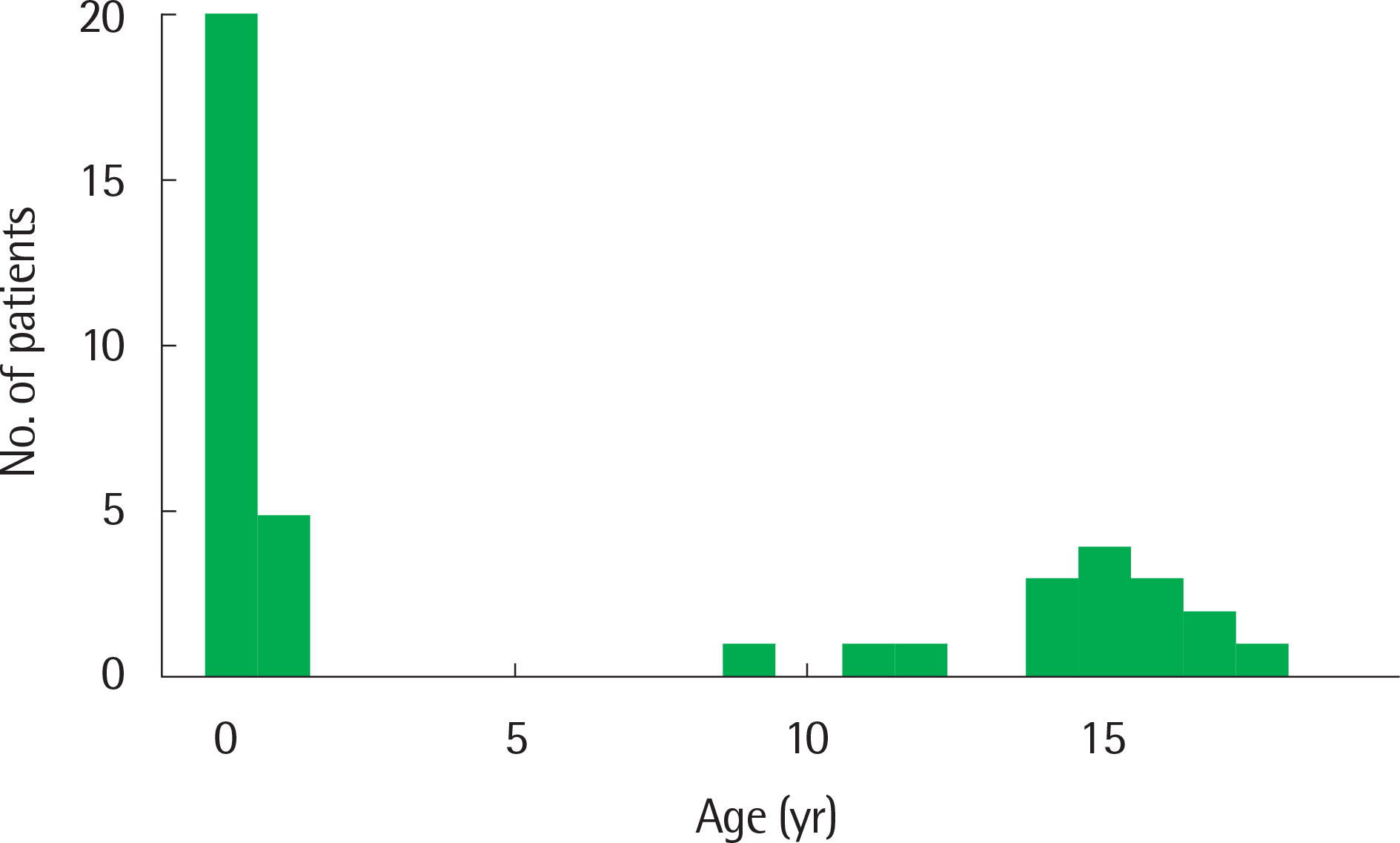Abstract
Purpose
Tracheostomy has been increasingly performed in children, along with the improvements in neonatal and pediatric intensive care. The objective of this study was to describe the indications, comorbidities, complications, and outcomes of tracheostomy in children in a tertiary hospital.
Methods
This was a retrospective study of children who required tracheostomy in a tertiary hospital in Korea between April 2009 and March 2018. The medical records of the patients were retrospectively reviewed and analyzed.
Results
A total of 41 children underwent tracheostomy. The median age of the patients was 11.9 months (interquartile range [IQR], 5.4–179.2 months), and 20 (48.8%) were boys. Tracheostomy was performed commonly in respiratory disease (12 [29.2%]) and neurologic disease (17 [41.5%]). The indications of tracheostomy differed according to patient age. There were trends toward longer length of intubation (median, 78.0 days; IQR, 36.0–185.0 days), longer hospitalization (213.3±154.5 days), higher decannulation rate (32.0%) and lower complications (12.0%) in patients who received tracheostomy as an infant/toddler.
Go to : 
References
1. Deutsch ES. Tracheostomy: pediatric considerations. Respir Care. 2010; 55:1082–90.
3. Kremer B, Botos-Kremer AI, Eckel HE, Schlöndorff G. Indications, complications, and surgical techniques for pediatric tracheostomies–an update. J Pediatr Surg. 2002; 37:1556–62.

4. Pereira KD, MacGregor AR, Mitchell RB. Complications of neonatal tracheostomy: a 5-year review. Otolaryngol Head Neck Surg. 2004; 131:810–3.

5. Carron JD, Derkay CS, Strope GL, Nosonchuk JE, Darrow DH. Pediatric tracheotomies: changing indications and outcomes. Laryngoscope. 2000; 110:1099–104.

6. Berry JG, Graham DA, Graham RJ, Zhou J, Putney HL, O'Brien JE, et al. Predictors of clinical outcomes and hospital resource use of children after tracheotomy. Pediatrics. 2009; 124:563–72.

7. Parrilla C, Scarano E, Guidi ML, Galli J, Paludetti G. Current trends in paediatric tracheostomies. Int J Pediatr Otorhinolaryngol. 2007; 71:1563–7.

8. Suh J, Lee JH, Chung MK, Jeong HS, Son YI, Ahn K, et al. Causes and outcome of tracheostomy in children. Pediatr Allergy Respir Dis. 2012; 22:188–96.

9. Lewis CW, Carron JD, Perkins JA, Sie KC, Feudtner C. Tracheotomy in pediatric patients: a national perspective. Arch Otolaryngol Head Neck Surg. 2003; 129:523–9.
10. Funamura JL, Durbin-Johnson B, Tollefson TT, Harrison J, Senders CW. Pediatric tracheotomy: indications and decannulation outcomes. Laryngoscope. 2014; 124:1952–8.

11. Lee JH, Smith PB, Quek MB, Laughon MM, Clark RH, Hornik CP. Risk factors and in-hospital outcomes following tracheostomy in infants. J Pediatr. 2016; 173:39–44.e1.

12. Wakeham MK, Kuhn EM, Lee KJ, McCrory MC, Scanlon MC. Use of tracheostomy in the PICU among patients requiring prolonged mechanical ventilation. Intensive Care Med. 2014; 40:863–70.

13. McPherson ML, Shekerdemian L, Goldsworthy M, Minard CG, Nelson CS, Stein F, et al. A decade of pediatric tracheostomies: Indications, outcomes, and longterm prognosis. Pediatr Pulmonol. 2017; 52:946–53.

14. Tsuboi N, Ide K, Nishimura N, Nakagawa S, Morimoto N. Pediatric tracheostomy: survival and longterm outcomes. Int J Pediatr Otorhinolaryngol. 2016; 89:81–5.

15. Mahida JB, Asti L, Boss EF, Shah RK, Deans KJ, Minneci PC, et al. Tracheostomy placement in children younger than 2 years: 30-day outcomes using the national surgical quality improvement program pediatric. JAMA Otolaryngol Head Neck Surg. 2016; 142:241–6.
16. Schweiger C, Manica D, Becker CF, Abreu LS, Manzini M, Sekine L, et al. Tracheostomy in children: a ten-year experience from a tertiary center in southern Brazil. Braz J Otorhinolaryngol. 2017; 83:627–32.

17. Watters K, O'Neill M, Zhu H, Graham RJ, Hall M, Berry J. Two-year mortality, complications, and healthcare use in children with medicaid following tracheostomy. Laryngoscope. 2016; 126:2611–7.

Go to : 
Table 1.
Demographics of subjects (n=41)
Table 2.
Indications for tracheostomy
| Indication | No. of patients (%) |
|---|---|
| Airway obstruction | 6 (14.6) |
| Subglottic stenosis | 1 (2.4) |
| Laryngomalacia | 4 (9.8) |
| Others* | 1 (2.4) |
| Respiratory disease | 12 (29.2) |
| Bronchopulmonary dysplasia | 6 (14.6) |
| Chronic respiratory failure | 6 (14.6) |
| Neurologic disease | 17 (41.5) |
| Hypoxic ischemic enphalopathy | 5 (12.2) |
| Intractable epilepsy | 3 (7.3) |
| Traumatic brain injury | 6 (14.6) |
| Others† | 3 (7.3) |
| Congenital muscular disease | 3 (7.3) |
| Craniofacial anomaly | 3 (7.3) |
Table 3.
Comorbidities in the patients
| Comorbidities | No. of patients (%) |
|---|---|
| Congenital heart disease | 12 (33.3) |
| Bronchopulmonary dysplasia | 6 (16.7) |
| Neurologic disease | 6 (16.7) |
| Gastrointestinal disease | 2 (5.5) |
| Genetic disorder | 6 (16.7) |
| Cancer | 3 (8.3) |
| Others* | 1 (2.8) |
Table 4.
Clinical characteristics of the patients
Table 5.
Patients with successful decannulation after tracheostomy




 PDF
PDF ePub
ePub Citation
Citation Print
Print



 XML Download
XML Download